MP24
| Group: Birchip Cropping Group | |
| Australian Soil Classification: Episodic-Epicalcareous, Self-mulching, Brown VERTOSOL | |
| General Landscape Description: Level alluvial plain within the Tyrell Creek Land System (Rowan and Downes, 1963). |
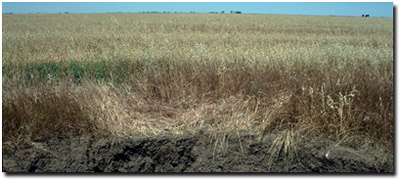 Site MP24 Landscape |
Soil Profile Morphology:
Surface Soil
| A1 | 0-10 cm | Dark brown (10YR4/3); light clay; self-mulching surface condition, friable consistence dry; surface cracking evident; pH 7.9: | 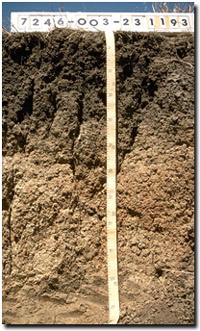 Site MP24 Profile |
| Subsoil | |||
| B21 | 10-30 cm | Dark brown (10YR4/3); medium clay (subplastic); moderate prismatic, parting to strong very fine blocky structure; pH 8.9: | |
| B22k | 30-55 cm | Brown (10YR5/3); light medium clay; very coarse prismatic, parting to strong medium to fine blocky structure; very firm to strong consistence dry; contains few (2-10%) fine earth carbonates; pH 9.1; sharp change to: | |
| B23 | 55-100 cm | Light yellowish brown (10YR6/4); light medium clay; structure similar to above; strong consistence dry; pH 9.0; gradual change to: | |
| B24 | 100-180 cm | Light medium clay; with soft manganese segregations in the 160 -180 cm zone; pH 9.1. | |
pH | Salinity Rating | |||
Surface (A1 horizon) | slightly alkaline | very low | sodic | none1 |
Upper Subsoil (B21 horizon) | strongly alkaline | medium | strongly sodic | moderate |
Deeper subsoil (at 1 m) | very strongly alkaline | very high | very strongly sodic | none2 |
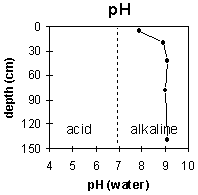 | 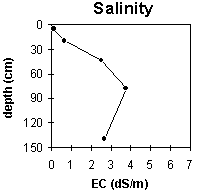 | 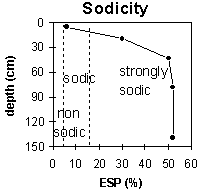 |
Horizon | Horizon Depth (cm) | pH (water) | pH (CaCl2) | EC ds/m | NaCI % | Exchangeable Cations | Field Capacity pF 2.5 | Wilting Point pF 4.2 | Coarse Sand (0.2 - 2.0 mm) | Fine Sand (0.02 -0.2 mm) | Silt (0.002 -0.02 mm) | Clay (<0.002 mm) | |||
Ca | Mg | K | Na | ||||||||||||
meq/100g | |||||||||||||||
A1 | 0-10 | 7.9 | 7 | 0.13 | 20.6 | 6.6 | 2.4 | 1.9 | 44 | 25 | 11 | 14 | 8 | 60 | |
B2 | 10-30 | 8.9 | 8 | 0.67 | 0.08 | 16.2 | 11.3 | 2.2 | 12.8 | 57 | 35 | 5 | 6 | 28 | 48 |
B22 | 30-55 | 9.1 | 8.6 | 2.5 | 0.47 | 8.6 | 12.4 | 2 | 22.7 | 59 | 35 | ||||
B23 | 55-100 | 9 | 8.6 | 3.78 | 0.76 | 7.7 | 12.8 | 1.7 | 23.9 | 53 | 26 | ||||
B24 | 100-180 | 9.1 | 8.7 | 2.7 | 0.54 | 7 | 12.2 | 1.4 | 22.3 | ||||||
Management Considerations:
Surface (A) Horizon
- Tillage or excessive trafficking of cracking clay soils should be avoided if the soil is very moist to wet (i.e. wetter than the plastic limit). At such moisture conditions, tillage or excessive trafficking can result in structural damage (e.g. compaction, smearing) occurring. Ideally, tillage and trafficking should take place when the soil is drier than the plastic limit (down to at least the tillage depth).
- The high wilting point value (25%) indicates that plants will be unable to utilise light rains falling on relatively dry soil.
- The upper subsoil is strongly sodic and dispersive. This will result in root and water movement being significantly restricted. The deeper subsoil below 30 cm depth becomes extremely sodic (and has a low exchangeable calcium to magnesium ratio) which will have a deleterious effect on soil structure and may create adverse chemical conditions for some plants.
- The level of soluble salts is medium in the upper subsoil (i.e. 10-30 cm depth). This may affect the growth of salt sensitive species (e.g. chick peas, lupins). The salinity rating becomes very high from 30 cm depth and the growth of a number of plant species (possibly including wheat, oats and barley) may be significantly restricted.
- The subsoil is strongly to very strongly alkaline throughout. This indicates that phosphorus and trace elements such as iron, manganese, copper and zinc may be poorly available to plants.


